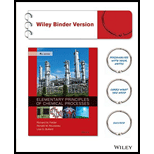
(a)
Interpretation:
To determine density of wood.
Concept introduction:
Archimedes’ principle states that a body which is at rest and placed in a fluid in such a manner that when it is submerged completely or partially then a buoyant force will act in the upward direction whose magnitude will be equal to the weight of displaced fluid.
As surrounding fluid is of uniform density so, the weight of displaced fluid is equal to the volume of the displaced fluid. It concludes that the mass of displaced fluid is equal to mass of object immersed in the fluid. The object immersed in fluid in this case is the cylinder. So, mass of displaced fluid is equal to mass of the cylinder.
(b)
Interpretation:
To determine the liquid density.
Concept introduction:
Archimedes’ principle states that a body which is at rest and placed in a fluid in such a manner that when it is submerged completely or partially then a buoyant force will act in the upward direction whose magnitude will be equal to the weight of displaced fluid.
As surrounding fluid is of uniform density so, the weight of displaced fluid is equal to the volume of the displaced fluid. It concludes that the mass of displaced fluid is equal to mass of object immersed in the fluid. The object immersed in fluid in this case is the cylinder. So, mass of displaced fluid is equal to mass of the cylinder.
(c)
Interpretation:
To explain why knowing length and width of the wooden object is unnecessary
Concept introduction:
Archimedes’ principle states that a body which is at rest and placed in a fluid in such a manner that when it is submerged completely or partially then a buoyant force will act in the upward direction whose magnitude will be equal to the weight of displaced fluid.
As surrounding fluid is of uniform density so, the weight of displaced fluid is equal to the volume of the displaced fluid. It concludes that the mass of displaced fluid is equal to mass of object immersed in the fluid. The object immersed in fluid in this case is the cylinder. So, mass of displaced fluid is equal to mass of the cylinder.
Want to see the full answer?
Check out a sample textbook solution
Chapter 2 Solutions
Elementary Principles of Chemical Processes, Binder Ready Version
 Introduction to Chemical Engineering Thermodynami...Chemical EngineeringISBN:9781259696527Author:J.M. Smith Termodinamica en ingenieria quimica, Hendrick C Van Ness, Michael Abbott, Mark SwihartPublisher:McGraw-Hill Education
Introduction to Chemical Engineering Thermodynami...Chemical EngineeringISBN:9781259696527Author:J.M. Smith Termodinamica en ingenieria quimica, Hendrick C Van Ness, Michael Abbott, Mark SwihartPublisher:McGraw-Hill Education Elementary Principles of Chemical Processes, Bind...Chemical EngineeringISBN:9781118431221Author:Richard M. Felder, Ronald W. Rousseau, Lisa G. BullardPublisher:WILEY
Elementary Principles of Chemical Processes, Bind...Chemical EngineeringISBN:9781118431221Author:Richard M. Felder, Ronald W. Rousseau, Lisa G. BullardPublisher:WILEY Elements of Chemical Reaction Engineering (5th Ed...Chemical EngineeringISBN:9780133887518Author:H. Scott FoglerPublisher:Prentice Hall
Elements of Chemical Reaction Engineering (5th Ed...Chemical EngineeringISBN:9780133887518Author:H. Scott FoglerPublisher:Prentice Hall
 Industrial Plastics: Theory and ApplicationsChemical EngineeringISBN:9781285061238Author:Lokensgard, ErikPublisher:Delmar Cengage Learning
Industrial Plastics: Theory and ApplicationsChemical EngineeringISBN:9781285061238Author:Lokensgard, ErikPublisher:Delmar Cengage Learning Unit Operations of Chemical EngineeringChemical EngineeringISBN:9780072848236Author:Warren McCabe, Julian C. Smith, Peter HarriottPublisher:McGraw-Hill Companies, The
Unit Operations of Chemical EngineeringChemical EngineeringISBN:9780072848236Author:Warren McCabe, Julian C. Smith, Peter HarriottPublisher:McGraw-Hill Companies, The





